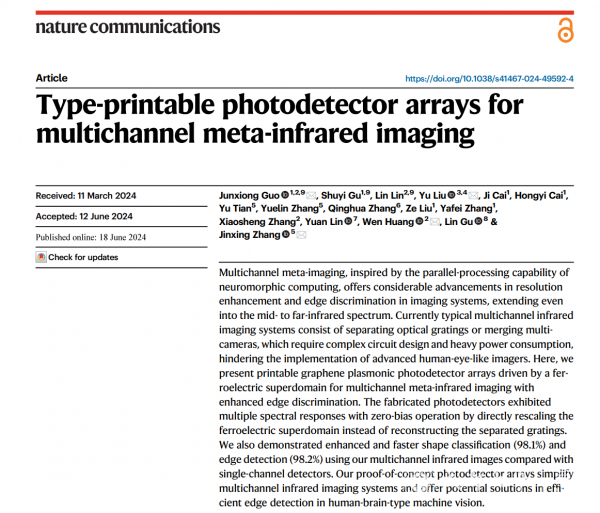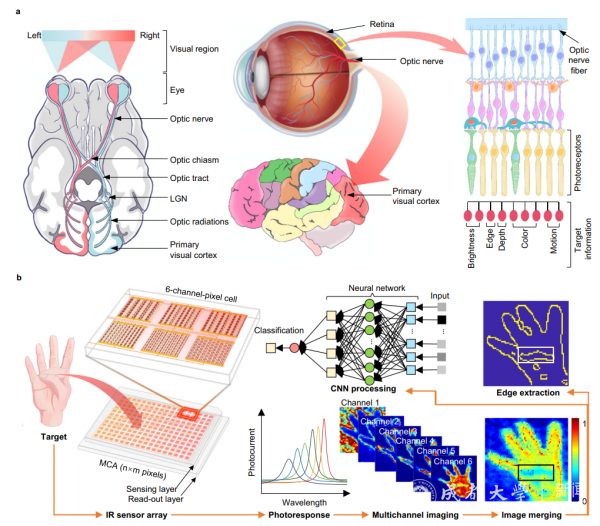On June 18, Dr. Guo Junxiong, a distinguished research fellow of the College of Electronic Information and Electrical Engineering of Chengdu University, published an academic paper entitled "Type-printable photodetector arrays for multichannel meta-infrared imaging" in Nature Communications in cooperation with the University of Electronic Science and Technology of China, Beijing Normal University, Tsinghua University, etc. Research fellow Guo Junxiong is the first author and corresponding author of this paper. Gu Shuyi, a postgraduate student jointly trained by the team and the Fifth research Institute of Telecommunications Technology, and Lin Lin, a doctoral student jointly trained by the University of Electronic Science and Technology of China are co-first authors. Professor Huang Wen from the University of Electronic Science and Technology of China, Doctor Liu Yu from Nanjing University of Posts and Telecommunications, and Professor Zhang Jinxing from Beijing Normal University are co-corresponding authors. Chengdu University is the affiliated institution of the first author and the corresponding author.

The research is funded by the Youth Program of the National Natural Science Foundation of China, the General Program of the Sichuan Natural Science Foundation, the High-level Talent Cultivation Plan of Chengdu University, etc.
This paper proposes a manufacturing technology of "type-printable" photodetector arrays for multichannel meta-infrared imaging similar to the human visual systems. The photodetector arrays consist of superstructure ferroelectric domains (arrays of periodically alternating upward and downward ferroelectric polarization domains) and a single-layer continuous graphene to achieve selective response to mid-infrared incident light at zero bias. Compared with the current multi-channel infrared imaging system, the new infrared system based on " type-printable" photodetector arrays does not need additional separate gratings or multi-type sensor fusion. The new system can achieve multi-channel infrared imaging by simply reconstructing the superstructure ferroelectric domain arrays. Meanwhile, after training with multiple images, the designed imaging system achieves classification accuracy of over 98.1% and 98.2% in gesture recognition and hidden target recognition respectively. This advancement presents a promising approach for designing state-of-the-art infrared imaging with low energy consumption, large-area arrays, and scalable fabrication.

As an open-access journal under Nature, Nature Communications publishes high-quality research results across all fields of the natural sciences. It is recognized as a top journal in SCI Zone I by the Chinese Academy of Sciences and is listed in the Nature Index. The journal boasts an impact factor of 16.6 for 2023-2024, with a five-year impact factor of 17. Papers published in this journal serve as important references for research in multidisciplinary fields.
The research team of micro-nano devices and integrated systems led by Researcher Guo Junxiong has previously published several papers in high-impact journals, such as Nano Letters (cover paper, 2023), IEEE Transactions on Information Forensics and Security (2023), Carbon (2022), Science China Technological Sciences (cover papers, 2024, 2022), etc. His main research interests are micro-nanobionic devices and artificial vision systems.
Background Information: https://www.nature.com/articles/s41467-024-49592-4